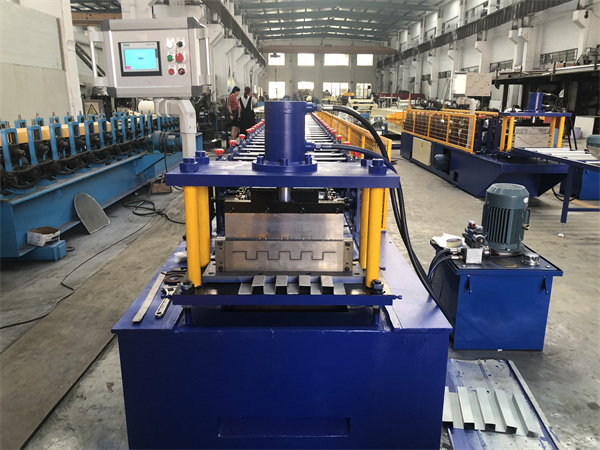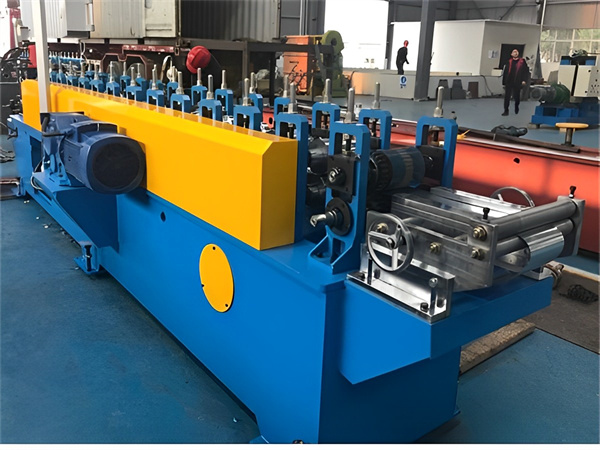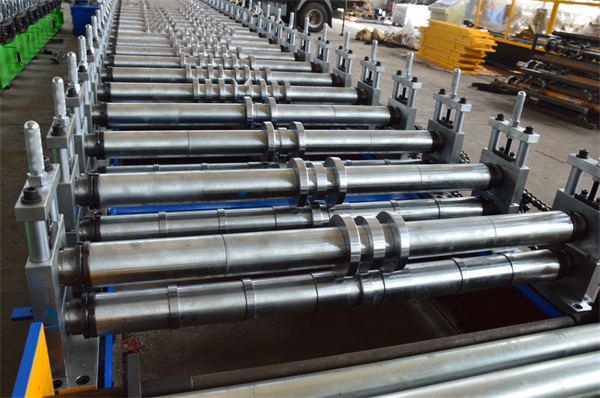परिचय
Ever heard the phrase, “bending steel to our will”? In the world of construction and manufacturing, this isn’t just a saying—it’s a reality. And one of the marvels behind this is the light steel roll forming machine.
Definition
A light steel roll forming machine is a device that shapes metal, especially steel, into desired profiles through a series of rollers. Think of it as a pasta maker, but instead of spaghetti or fettuccine, we’re making steel channels or profiles.
Historical Background
Roll forming isn’t new. Ancient civilizations used primitive forms of rolling to shape metals. With the industrial revolution and the rise in demand for infrastructure, roll forming machines evolved, becoming integral in modern construction and manufacturing.

Working Principle of the Machine
Ever wondered how a simple sheet of metal turns into a complex shape? Here’s the magic behind it:
Fundamental Mechanics
The process begins with feeding a metal sheet or coil into the machine. As this sheet progresses, it passes through a series of rollers, each one molding the metal a bit more, until the desired shape is achieved at the end.
Components Involved
Major components include the uncoiler (which holds the metal coil), the rollers (the heart of the machine), and a cutting mechanism to snip the formed metal at precise lengths.
Advantages of Using Light Steel Roll Forming Machine
- क्षमता: Roll forming machines automate the process of shaping steel coils into desired profiles. This automation leads to higher production efficiency compared to manual methods, resulting in reduced labor costs and faster production cycles.
- Precision and Consistency: Roll forming machines offer high precision and consistency in producing steel components. The process ensures that each piece has the same dimensions and characteristics, reducing errors and inconsistencies that might occur with manual fabrication.
- Flexibility: Light steel roll forming machines can produce a wide range of profiles, shapes, and sizes. This versatility allows manufacturers to quickly switch between different product designs without the need for major adjustments or retooling.
- Material Savings: Roll forming optimizes the use of raw materials, reducing waste and minimizing scrap. The process produces components with minimal material thinning and deformation, resulting in efficient material utilization.
- Cost-Effective: Over time, the initial investment in a roll forming machine can lead to cost savings due to improved efficiency, reduced material waste, and lower labor requirements. This makes the production process more cost-effective in the long run.
- Speed of Production: Roll forming machines are capable of producing components at a high rate, contributing to shorter lead times and faster delivery to customers. This is especially important in industries with tight project schedules.
- Quality and Durability: Light steel roll forming machines can consistently produce high-quality components with uniform dimensions and characteristics. The resulting products tend to have good structural integrity and durability, meeting or exceeding industry standards.
- Reduced Manual Labor: By automating the forming process, roll forming machines decrease the need for manual labor in the production process. This can lead to safer working conditions, reduced labor costs, and a decreased reliance on skilled labor.
- Design Flexibility: Manufacturers can design custom profiles to meet specific project requirements. Roll forming technology can accommodate complex shapes and features, allowing for creative and functional designs.
- Less Tooling and Setup: Once the roll forming machine is set up for a specific profile, the changeover to a different profile is relatively quick and straightforward. This minimizes downtime during production shifts.
- Low Maintenance: Roll forming machines are designed for durability and require relatively low maintenance. Regular maintenance routines can help keep the machines in good working condition and extend their operational lifespan.
- ऊर्जा दक्षता: Roll forming machines generally consume less energy compared to other metal forming processes, contributing to environmental sustainability and lower operating costs.

Types of Light Steel Roll Forming Machines
- C/U/Z Purlin Roll Forming Machine: These machines produce C-shaped, U-shaped, and Z-shaped purlins, which are widely used in the construction industry as structural components for framing roofs and walls.
- Decking Sheet Roll Forming Machine: This type of machine produces corrugated metal sheets or floor decking panels used in construction for creating reinforced concrete floors.
- Roof Panel Roll Forming Machine: Roof panel roll formers produce various types of roofing panels, such as corrugated sheets, standing seam panels, and other profiles used for residential, commercial, and industrial roofs.
- Wall Panel Roll Forming Machine: Wall panel roll formers create different wall cladding profiles that are used for exterior and interior walls of buildings.
- Stud and Track Roll Forming Machine: These machines manufacture metal studs and tracks used in framing interior walls and partitions, commonly found in both residential and commercial construction.
- Shutter Door Roll Forming Machine: Shutter door roll formers produce slats or profiles used in manufacturing roller shutter doors for industrial, commercial, and residential applications.
- Gutter Roll Forming Machine: Gutter roll formers create gutter profiles used for collecting and directing rainwater away from buildings.
- Downspout Roll Forming Machine: Downspout roll forming machines produce downspout or rainwater pipe profiles that connect gutters to the ground drainage system.
- Tray Cable Roll Forming Machine: These machines produce cable trays used for organizing and supporting electrical cables in commercial and industrial environments.
- Rack Beam Roll Forming Machine: Rack beam roll formers create beams and uprights used in storage rack systems for warehouses and distribution centers.
- Guardrail Roll Forming Machine: Guardrail roll forming machines produce profiles used for highway safety barriers and guardrails.
- Solar Panel Mounting Structure Roll Forming Machine: These machines manufacture mounting structures for solar panels, ensuring they are securely attached to roofs or ground-based systems.
- Light Steel Framing Roll Forming Machine: These versatile machines produce various components for light steel framing systems used in residential and commercial construction, such as joists, headers, and studs.
Applications and Industries Served
- Construction Industry:
- Residential Construction: Light steel roll forming machines are used to produce components for residential buildings, including roof panels, wall panels, floor decking, and framing elements.
- Commercial Construction: They are employed in the creation of steel components for commercial structures, such as office buildings, shopping centers, and warehouses.
- Industrial Construction: These machines are utilized to manufacture components for industrial buildings, factories, and manufacturing facilities.
- Infrastructure and Transportation:
- Highway Safety: Roll forming machines produce guardrails and safety barriers used along highways and roads to enhance driver safety.
- Railings: They create railing systems for pedestrian walkways, bridges, and staircases in both public and private infrastructure projects.
- Transportation Equipment: Light steel roll forming machines are used to manufacture parts for transportation equipment like buses, trucks, trailers, and railway cars.
- Energy and Renewable Industries:
- Solar Energy: They create mounting structures for solar panels, allowing for efficient and secure installation on rooftops and ground-based systems.
- Wind Energy: Light steel components produced by these machines can be used in wind turbine towers and support structures.
- Storage and Warehousing:
- Storage Racks: Roll forming machines produce beams, uprights, and other components used in storage rack systems for warehouses, distribution centers, and retail environments.
- Electrical and Electronics:
- Cable Trays: These machines are used to manufacture cable trays for organizing and supporting electrical cables in commercial and industrial settings.
- Agriculture and Farming:
- Agricultural Buildings: Light steel components are used in constructing agricultural buildings like barns, storage facilities, and equipment sheds.
- Residential and Commercial Interiors:
- Interior Partitions: Light steel roll forming machines produce studs and tracks used in constructing interior partitions, room dividers, and suspended ceilings.
- Automotive Industry:
- Auto Parts: These machines can create components used in the automotive industry, such as support structures, brackets, and panels.
- Furniture Manufacturing:
- Furniture Components: Light steel profiles produced by these machines are used in creating furniture frames and structures.
- Home Improvement and Renovation:
- Roofing and Siding: Roll forming machines produce roofing panels, siding panels, and other exterior components used in home improvement projects.
- Healthcare and Medical Industry:
- Hospital Structures: Light steel components are used in constructing healthcare facilities like hospitals, clinics, and medical centers.
- Retail and Commercial Displays:
- Store Fixtures: These machines can produce components for retail displays, store fixtures, and commercial interiors.

Maintaining a Roll Forming Machine
Like any machine, upkeep is essential:
Regular Check-ups
Always inspect for wear and tear, ensuring the machine is in optimal working condition.
Lubrication and Cleaning
Keep those rollers moving smoothly with regular lubrication and thorough cleaning.
Future Trends and Innovations
As technology evolves, so do roll forming machines:
Technological Advancements
Integration of AI and automation for even more precision and efficiency.
Green Initiatives
With increasing focus on sustainability, eco-friendly roll forming machines are becoming more prevalent.
निष्कर्ष
The light steel roll forming machine is not just a tool—it’s a testament to human ingenuity. From shaping the structures we live and work in to influencing the transportation we use, its impact is felt daily. As technology and sustainability merge, the future of roll forming looks brighter than ever.
पूछे जाने वाले प्रश्न
What metals can a roll forming machine process?
While primarily used for steel, they can also handle aluminum, brass, and other metals.
Is it suitable for small-scale operations?
Absolutely! There are compact models available for smaller operations.
How energy-intensive is a roll forming machine?
Modern machines are designed to be energy efficient, though exact consumption varies by model and use.
How often should I service my roll forming machine?
Regular maintenance is key. Monthly check-ups are ideal, but this can vary based on usage.
Can I customize the shapes produced?
Yes, by adjusting the rollers or changing them out, different profiles can be produced.
